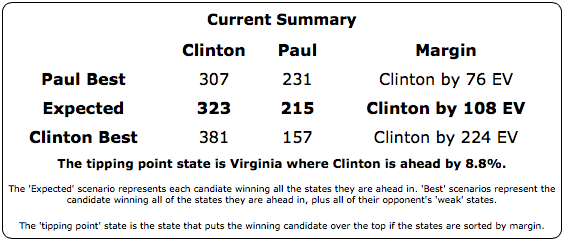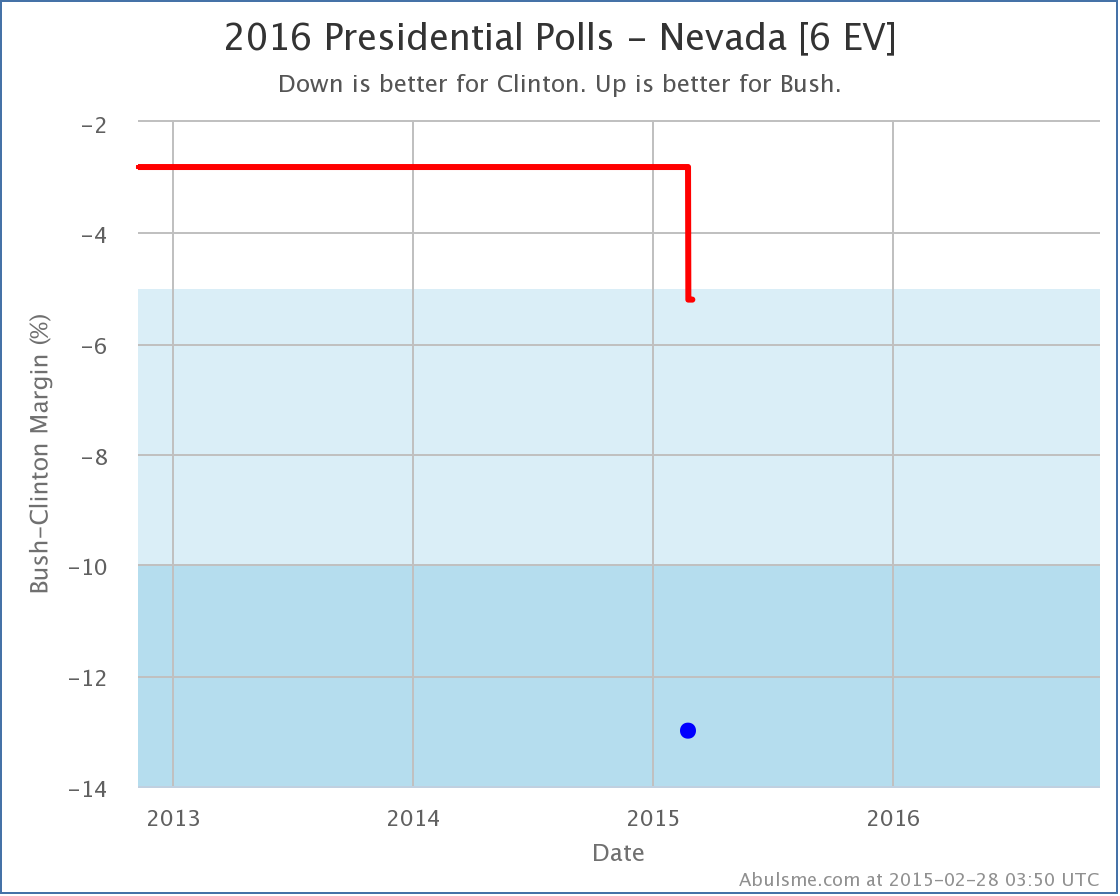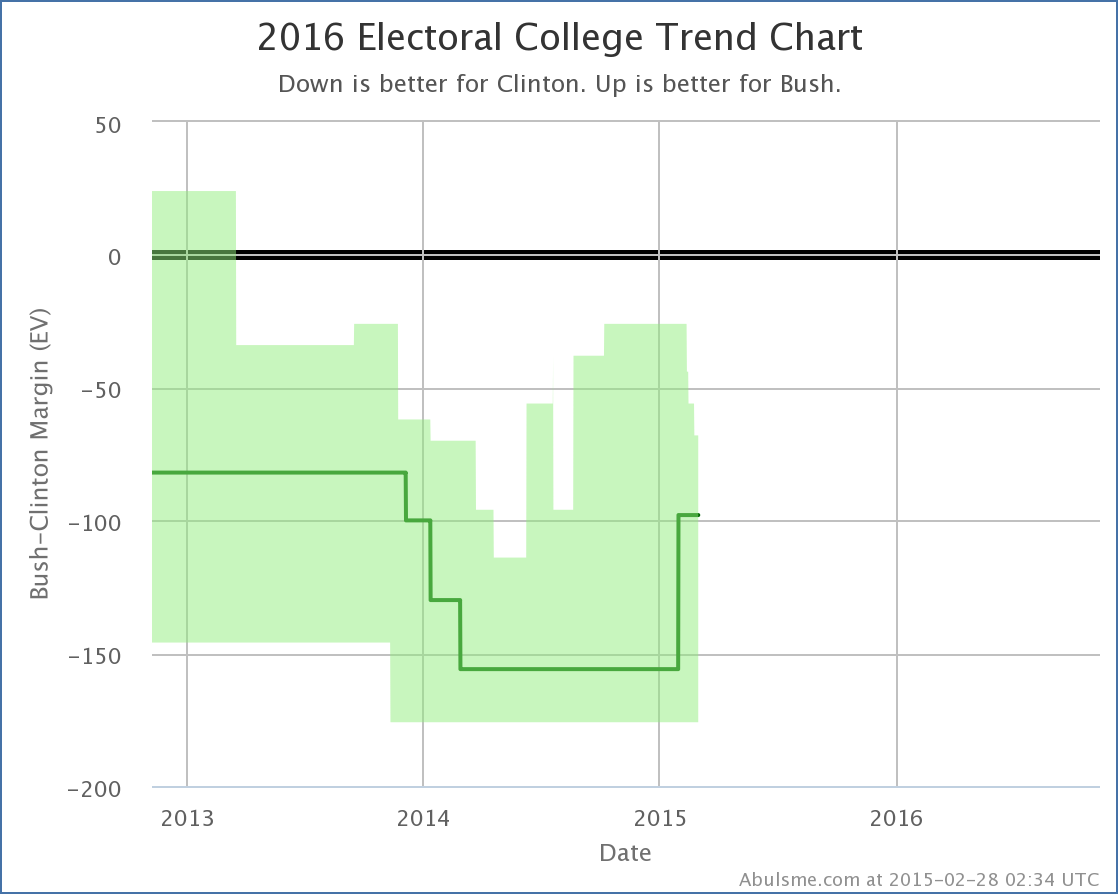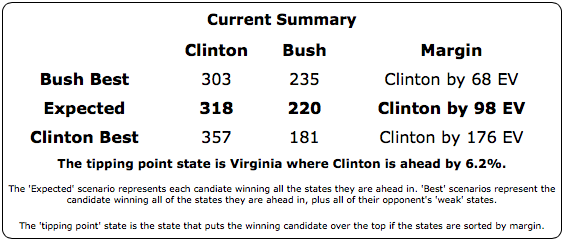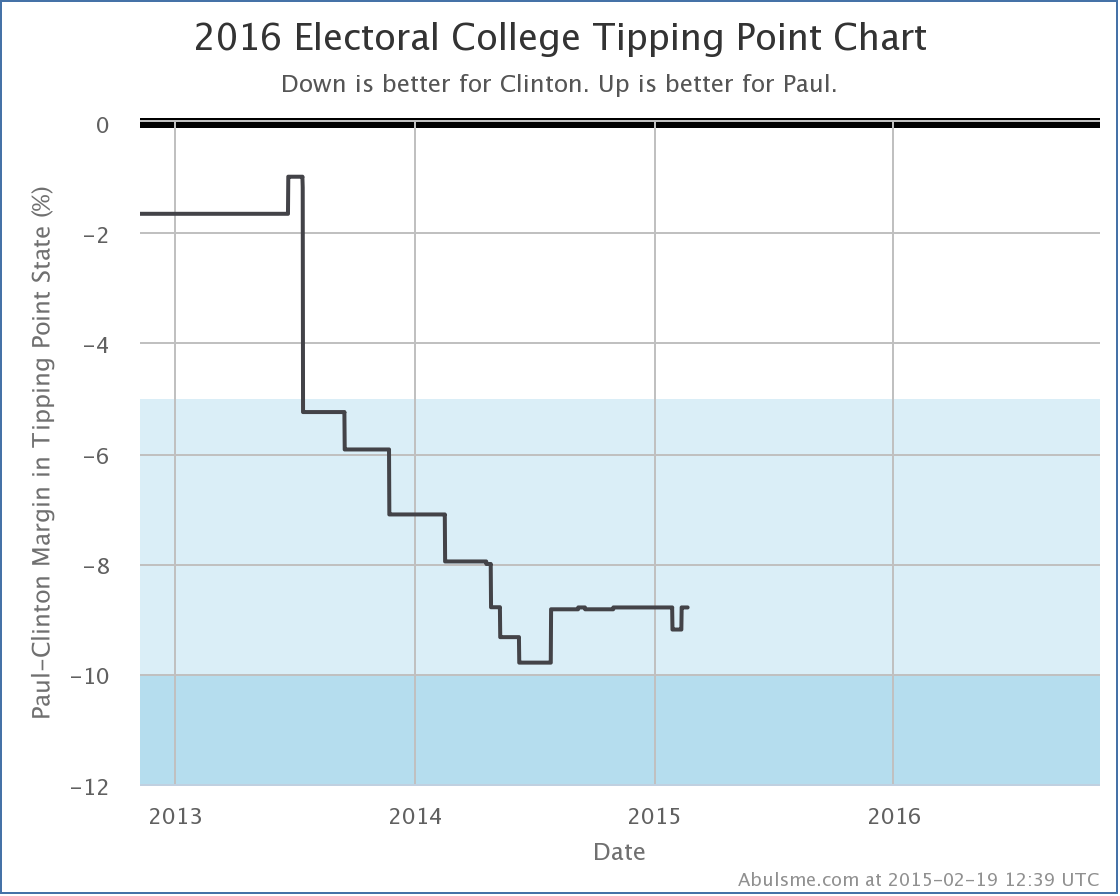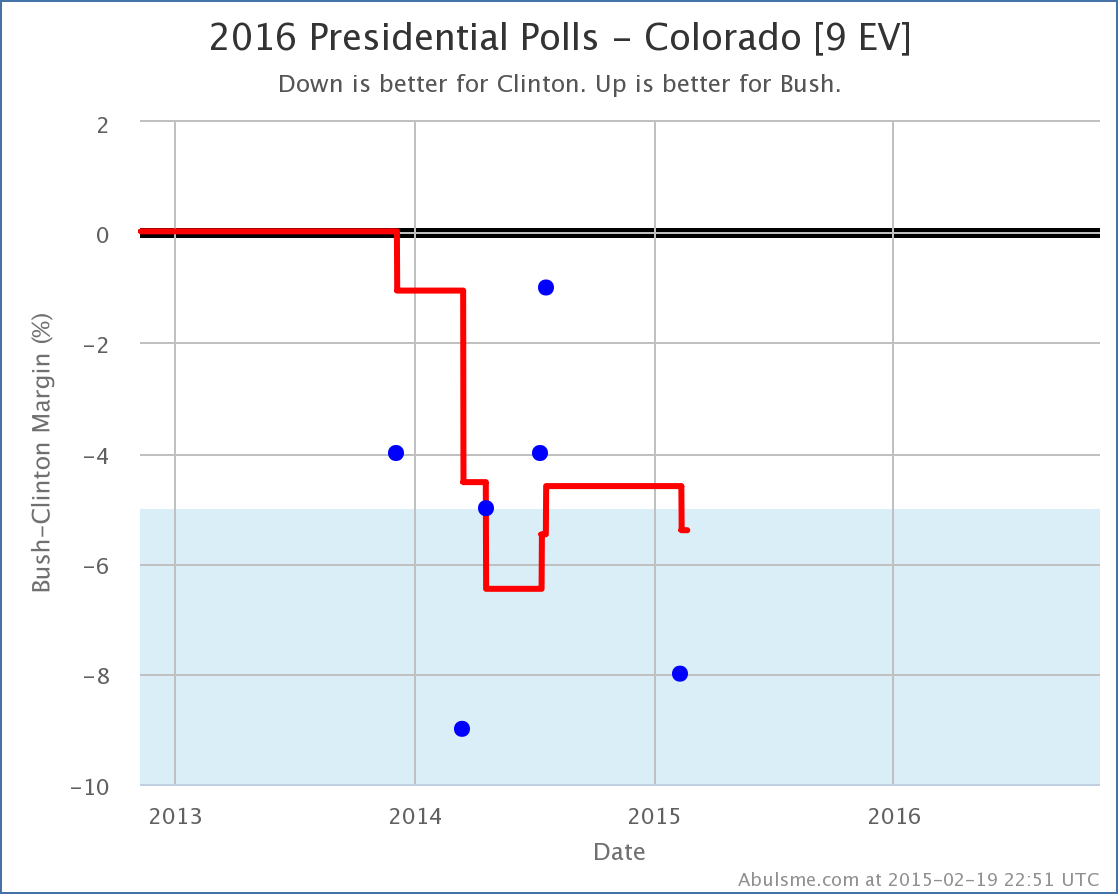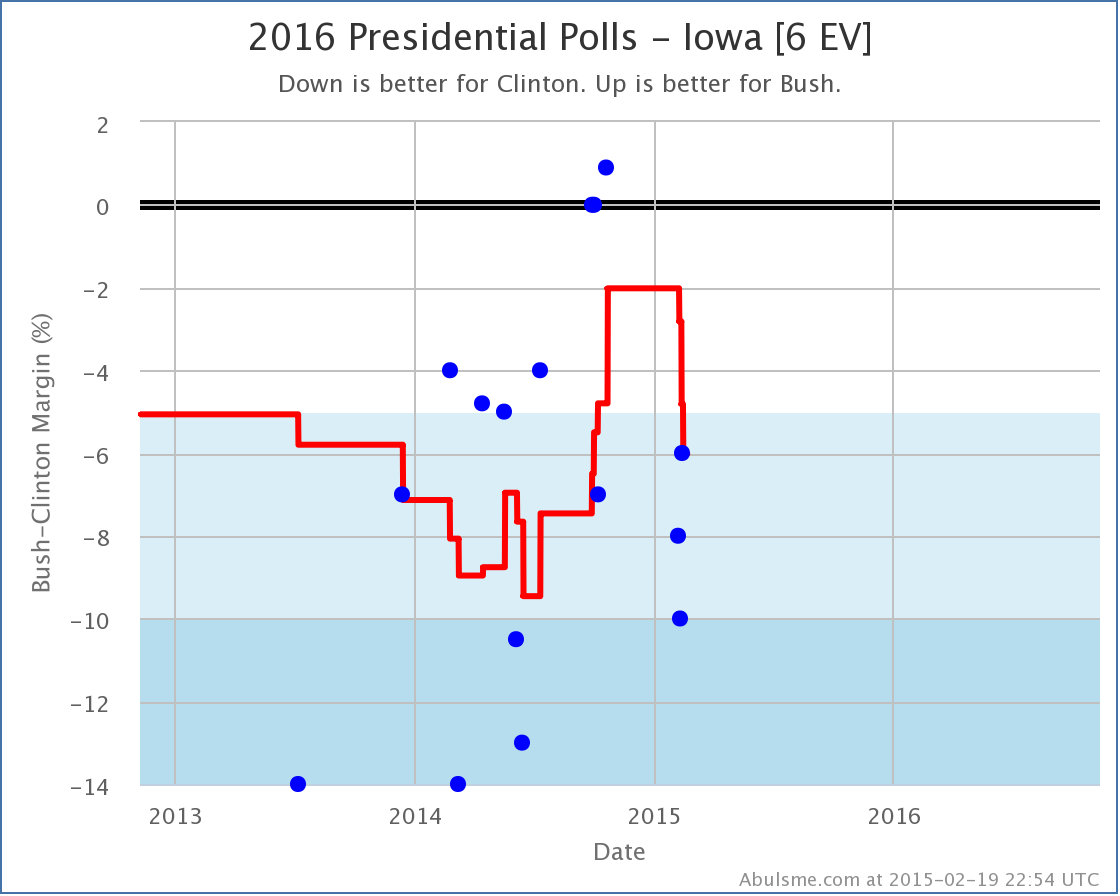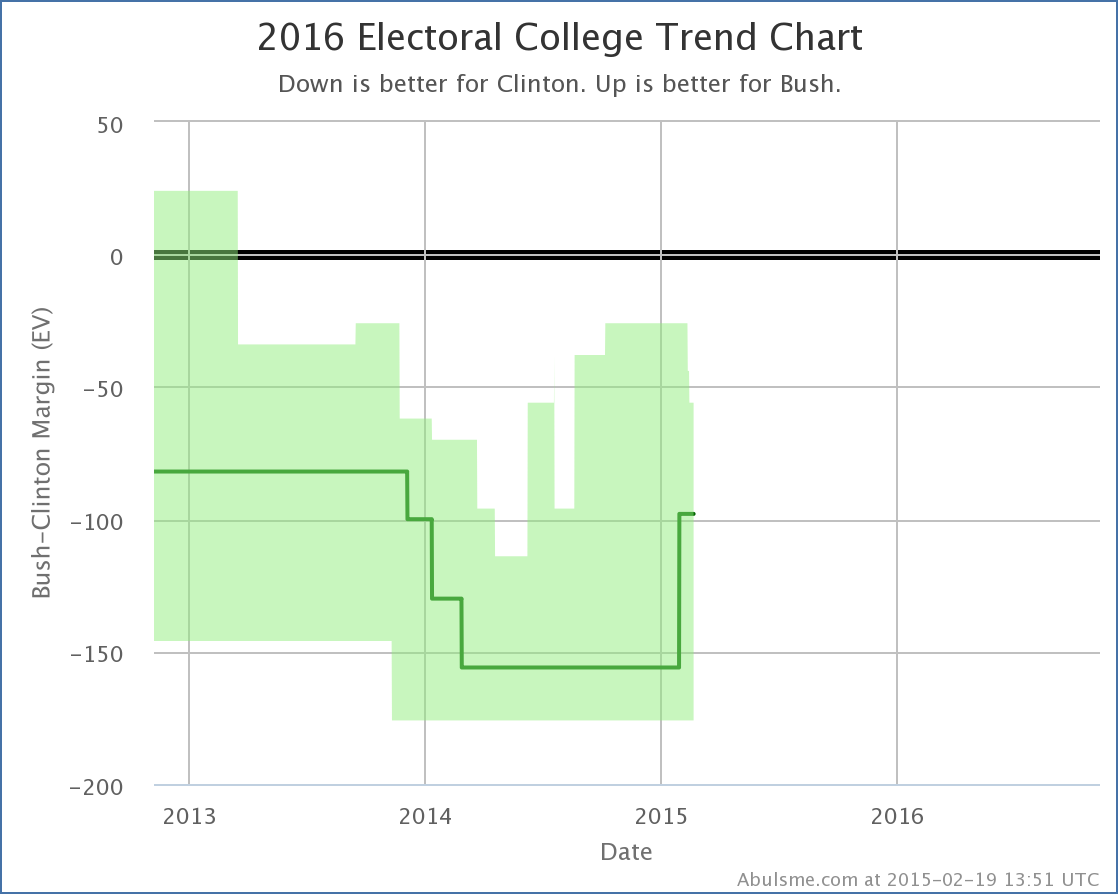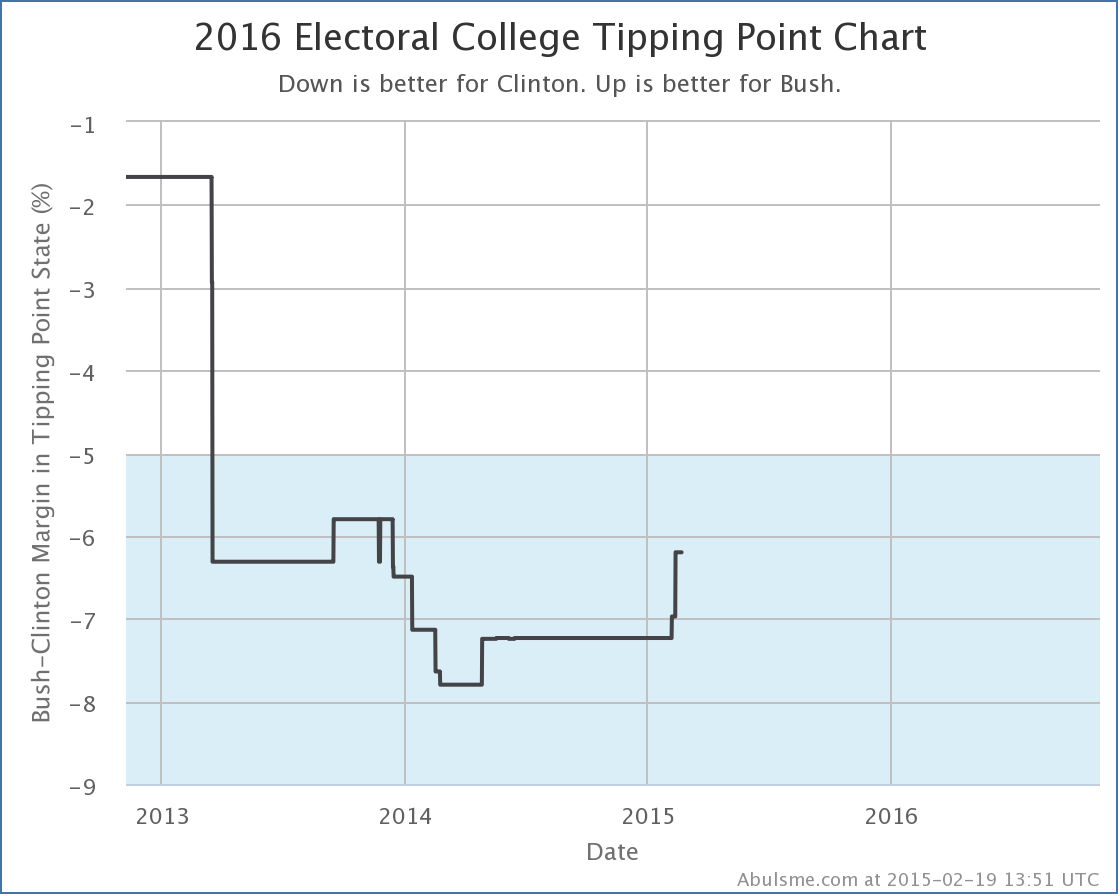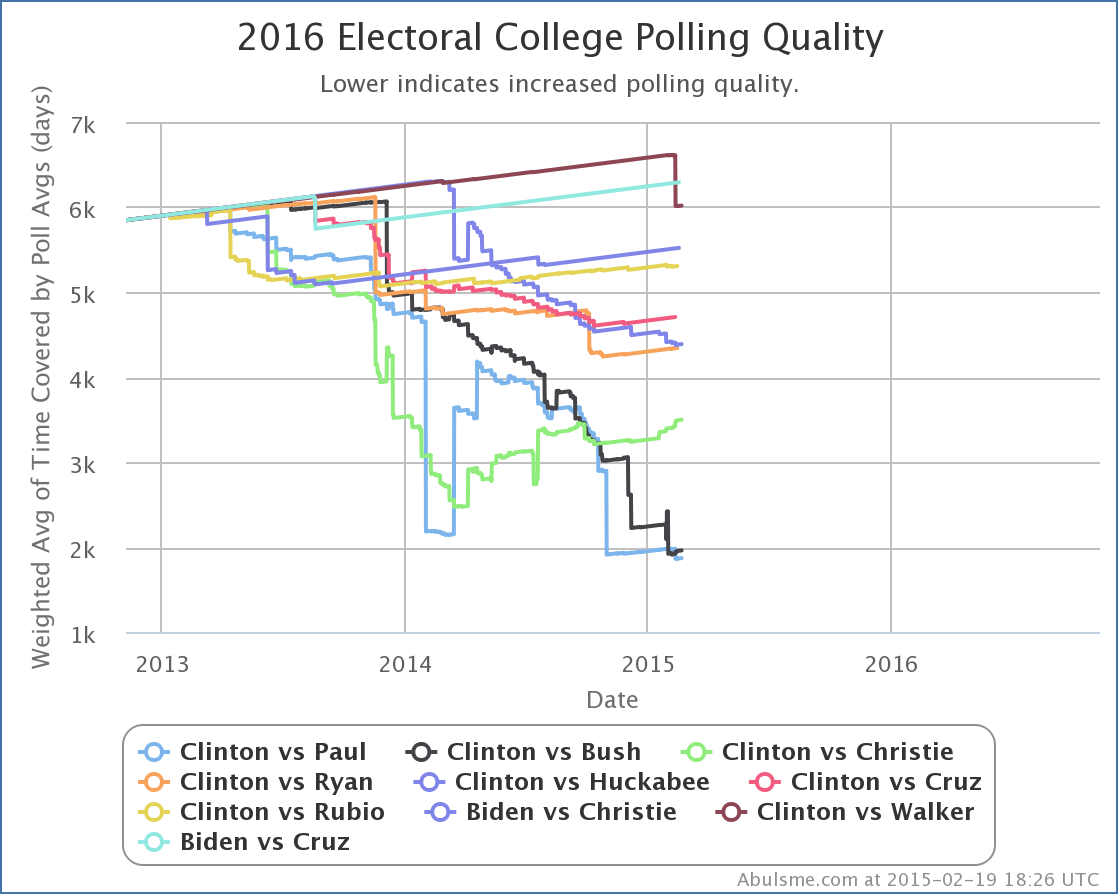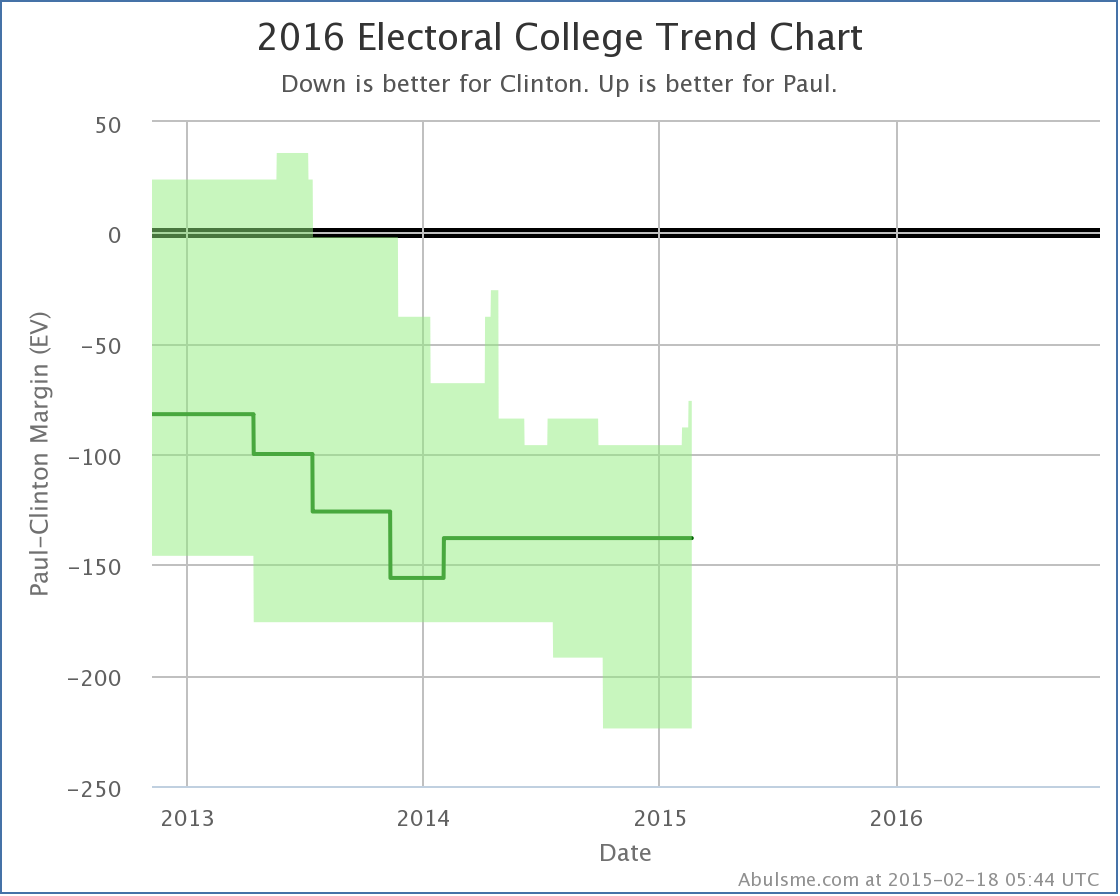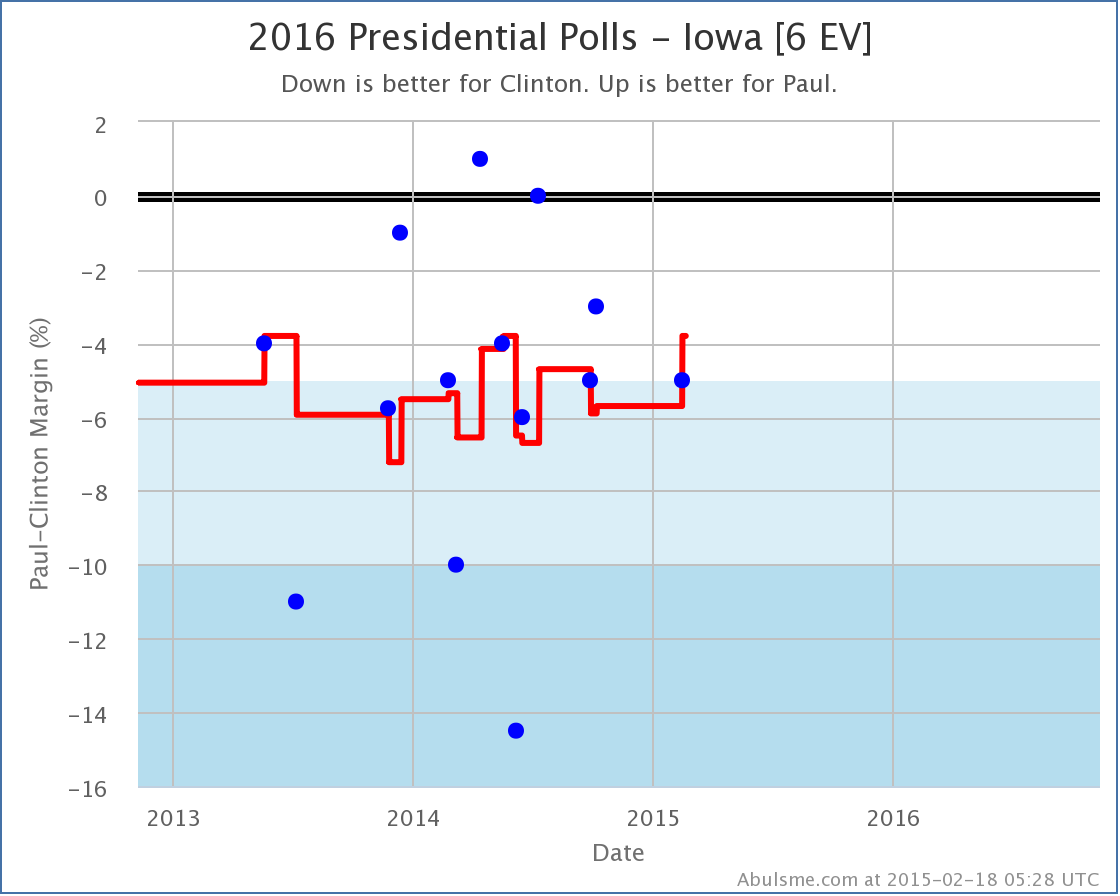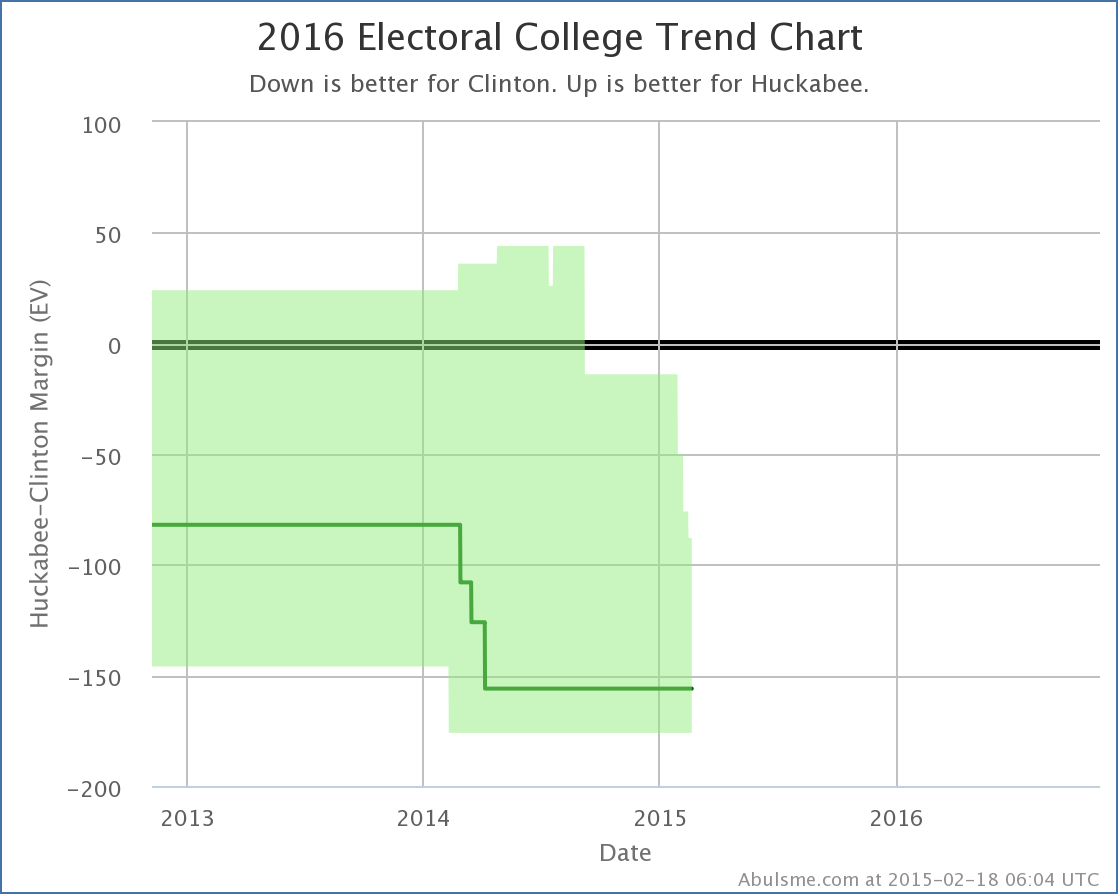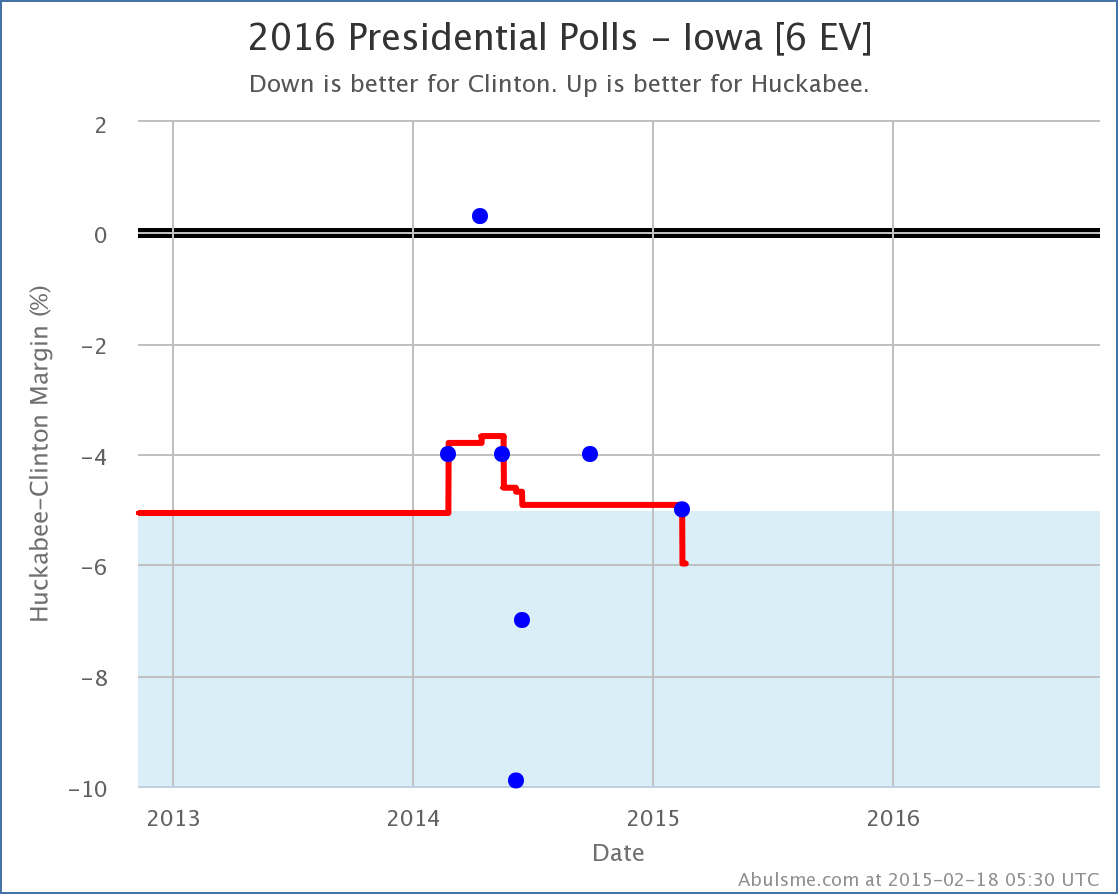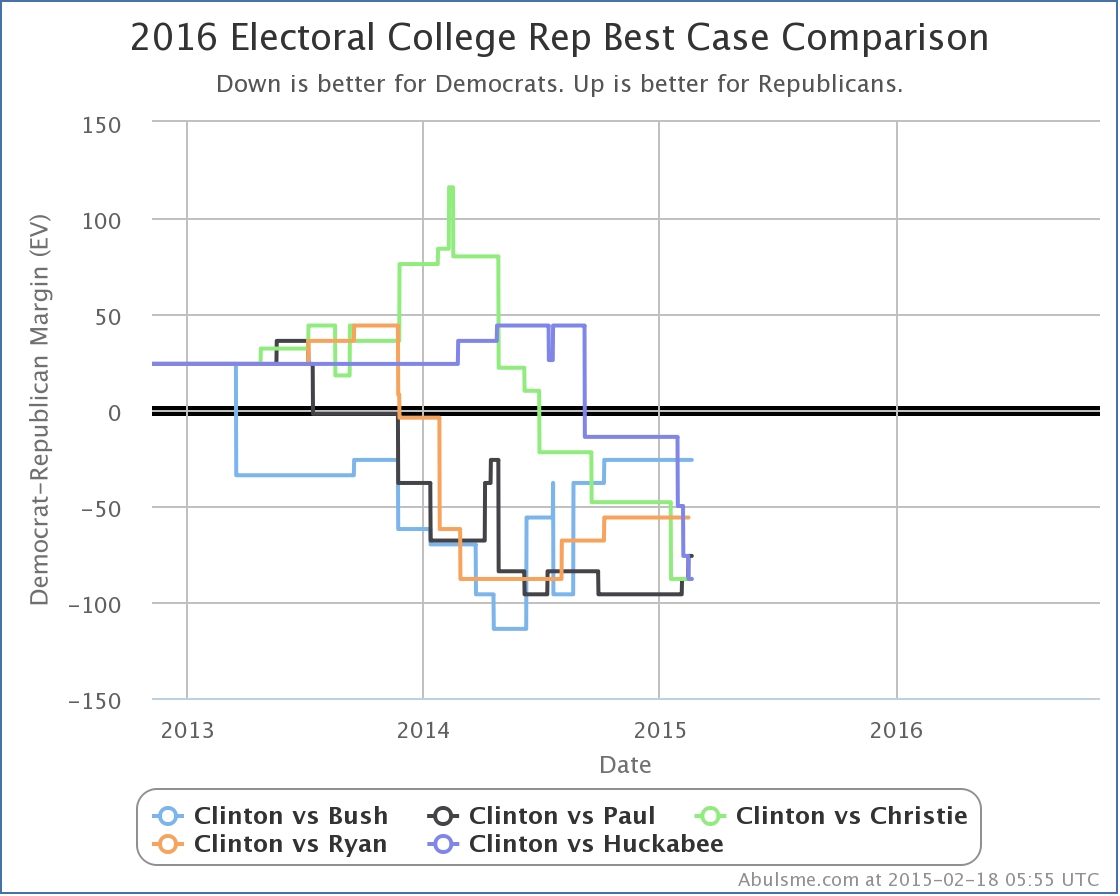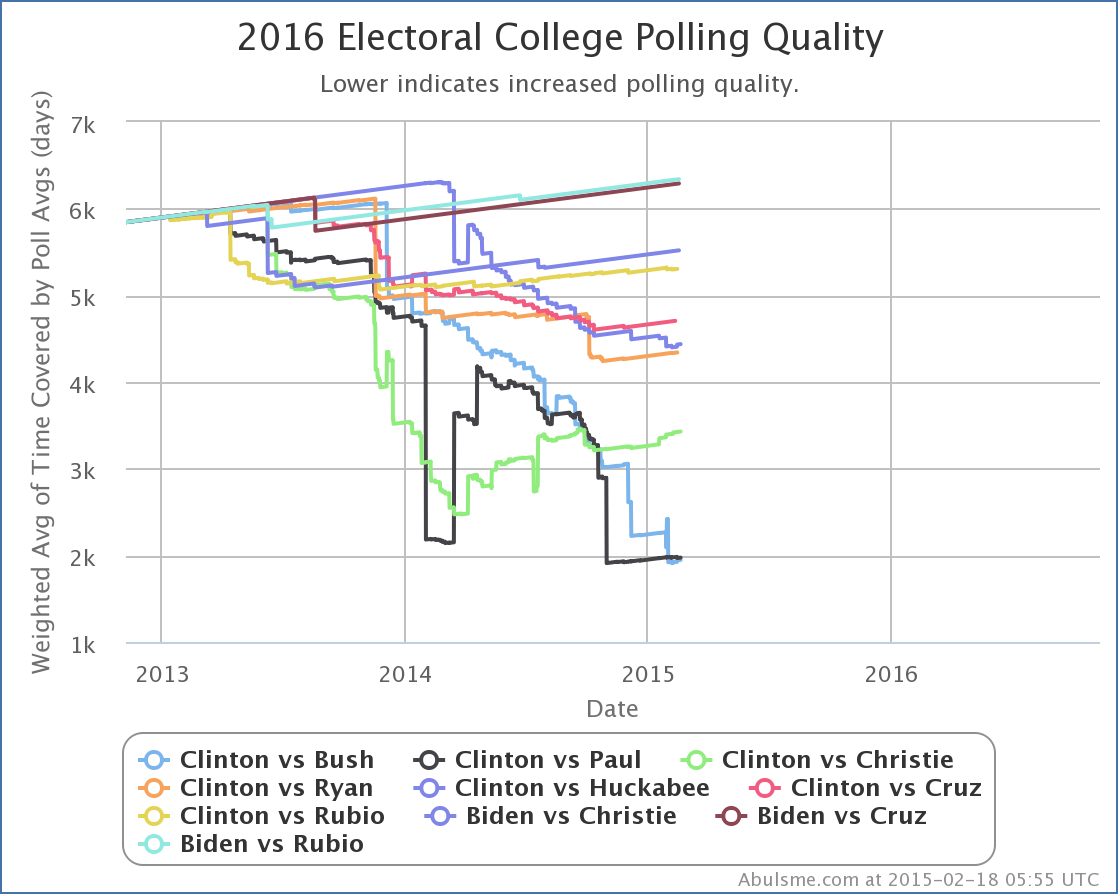- 02:31:58 Poll Added: PPP in NC from 2015-02-24 to 2015-02-26 – Clinton 46% to Bush 42% http://t.co/iQeXPBgHC7
- 02:34:24 Poll Added: PPP in NC from 2015-02-24 to 2015-02-26 – Biden 40% to Bush 47% http://t.co/RnXbZAQ1Lm
- 02:34:35 Biden vs Bush state category change: NC has moved from Strong Bush to Weak Bush http://t.co/RnXbZAQ1Lm
- 02:36:48 Poll Added: PPP in NC from 2015-02-24 to 2015-02-26 – Warren 38% to Bush 44% http://t.co/fFkzLUbsSB
- 02:39:03 Poll Added: PPP in NC from 2015-02-24 to 2015-02-26 – Clinton 45% to Carson 46% http://t.co/RUITDulNzf
- 02:40:39 Poll Added: PPP in NC from 2015-02-24 to 2015-02-26 – Clinton 45% to Christie 42% http://t.co/U4K5ABNv1G
- 02:42:24 Poll Added: PPP in NC from 2015-02-24 to 2015-02-26 – Clinton 47% to Cruz 43% http://t.co/ov3rrL2OK8
- 02:44:05 Poll Added: PPP in NC from 2015-02-24 to 2015-02-26 – Clinton 46% to Huckabee 46% http://t.co/NPvIfZ54zB
- 02:45:54 Poll Added: PPP in NC from 2015-02-24 to 2015-02-26 – Clinton 46% to Paul 43% http://t.co/GLiX03URH0
- 02:46:05 Clinton vs Paul state category change: NC has moved from Weak Clinton to Weak Paul http://t.co/GLiX03URH0
- 02:48:26 Poll Added: PPP in NC from 2015-02-24 to 2015-02-26 – Clinton 47% to Perry 44% http://t.co/oF138rDJfc
- 02:48:50 Clinton vs Perry state category change: NC has moved from Strong Perry to Weak Perry http://t.co/oF138rDJfc
- 02:50:34 Poll Added: PPP in NC from 2015-02-24 to 2015-02-26 – Clinton 45% to Walker 43% http://t.co/hoTYkG7SP2
- 02:52:57 Poll Added: PPP in NC from 2015-02-24 to 2015-02-26 – Clinton 46% to Rubio 42% http://t.co/kZQIJTrfLm
- 03:31:33 Biden best case vs Bush has changed: Biden 342 to Bush 196 -> Biden 357 to Bush 181 http://t.co/cL3JYCnKJv
- 03:50:08 Clinton vs Paul expected case changed: Clinton 338 to Paul 200 -> Clinton 323 to Paul 215 http://t.co/GWMqa6ULfF
- 03:50:39 Clinton best case vs Perry has changed: Clinton 380 to Perry 158 -> Clinton 395 to Perry 143 http://t.co/tmBf8hkT8H
- 07:36:38 [Blog Post] "Electoral College: Paul now ahead in North Carolina average vs Clinton" http://t.co/XaUP9ukAgK
| Abulsme.com | Abulsme Blog | Election Graphs | Curmudgeon's Corner Podcast |
| True Binary Clock | Random Trips | Live WebCam |
|
Today’s poll update consisted entirely of a new release of North Carolina data from PPP. They polled 11 different candidate combinations for 2016. Only one of these caused a category change for one of the top five “best polled” candidate pairs. That would be Clinton vs Paul: Although the most recent poll has Paul behind by 3%, the poll it replaces in the average had Paul behind by 5%, so the average moves from an 0.2% Clinton lead to an 0.2% Paul lead. Now, to be clear, just barely on one side of the line vs just barely on the other side of the line, either way this is about as close to a tie as you can get. (Especially since the way I calculate polling averages actually doesn’t allow ties, since it will pull in older polls to break any ties that might otherwise come up.) The spread of the last five polls is from Clinton by 5% to Paul by 6%, so there is a lot of uncertainty here too. Basically, North Carolina is a toss up. But that’s what being “Weak” means in my model anyway. We allow the state to swing from side to side in calculating the range of possible outcomes. But for now, this does push the “Expected Margin” in Paul’s direction: Still way behind to be sure, but every change in the Clinton vs Paul margin range numbers in the last few months has been in Paul’s direction. Bush, Christie and Huckabee were also in this latest batch of North Carolina polls, so lets look quickly at the comparison chart as well:
Ignore Clinton vs Ryan, which has never been polled in North Carolina. All of the candidates have been improving against Clinton in the last few months. Paul is just the first to flip the state. Bush was very close, but the last two polls including him didn’t go his way, so he pulled back a bit. But even Christie looks like he may have bottomed out and is now improving again. In North Carolina at least, the trend seems to be away from Clinton and toward the various Republican contenders. As usual though, the usual caveats apply on how sparse polling still is, just how far away from the election we still are, and how the very next poll may change the trend. Final thing to mention, with today’s new data Clinton vs Huckabee passed Clinton vs Ryan to take the #4 spot in my “Top 5 best polled” list. Given that Ryan has said he is not going to run, it probably won’t be that long until he drops off the top 5. Cruz, Rubio and Walker (all vs Clinton) have all gotten recent polling attention that is improving their polling situation. Given all the recent attention, my bet would be on Walker, even though of this bunch he is currently furthest behind in my polling quality metric, but we shall see… Note: This post is an update based on the data on my 2016 Electoral College Analysis Site. All of the charts and graphs seen here are from that site. Graphs, charts and raw data can be found there for the race nationally and in each state for every candidate combination that has been polled at the state level. In addition, comparisons of the best polled candidate combinations both nationally and each in each state are available. All charts above are clickable to go to the current version of the detail page the chart is from, which may contain more up to date information than the snapshots on this page, which were current as of the time of this post.
There were six states where the average margin over the last five presidential elections was less than 5%. Those states were Nevada, Ohio, Florida, Colorado, Virginia and Missouri. Since the 2012 election we’ve had lots of 2016 general election match up polls in Ohio, Florida, Colorado and Virginia. But nothing in Nevada or Missouri. No polls at all. Today I added the first Nevada results for the 2016 cycle, a recent poll from Gravis. The only category change coming out of this was for Clinton vs Bush. The margin over the past five elections in Nevada had ranged from the Republican by 3.5% (in 2000) to the Democrat by 12.5% (in 2008), but the average was Democrats by 2.8%, which gave Nevada an initial classification of “Weak Clinton”. Gravis polled five different Republicans against Clinton. One of them (Sandoval) actually beat Clinton. The rest lost, and generally by a worse margin than the old average, but not by enough to push the average into a new category. Bush on the other hand did VERY badly in this poll, losing to Clinton 50% to 37%, or a 13% margin. As the first actual head to head polling in Nevada, we’re still basing things primarily on old presidential election results, but that bad a result was able to single handedly move the the average to a 5.2% Clinton lead, and thus moved Nevada into the “Strong Clinton” category. According to my simple model, this takes the state out of the list of possible Bush wins. At least for now… Perhaps this poll is an outlier and the next poll will make the state closer again. With one real poll, you wouldn’t want to feel too confident of what this stare really looks like quite yet. For now though, this of course further lowers Bush’s “best case”: This makes the full national summary for Clinton vs Bush look like this today: Now, this doesn’t look great for Bush, but he may start improving in Nevada (and other states) as we start getting into real campaigning. Maggie Haberman is reporting in the New York Times that the first TV ads specifically targeting Clinton will air this weekend. These of course will not be the last. It will not be surprising to see things move toward the Republicans as this process gets into full swing. And of course we still need polls in Missouri. :-) So… stay tuned. Note: This post is an update based on the data on my 2016 Electoral College Analysis Site. All of the charts and graphs seen here are from that site. Graphs, charts and raw data can be found there for the race nationally and in each state for every candidate combination that has been polled at the state level. In addition, comparisons of the best polled candidate combinations both nationally and each in each state are available. [Edit 06:06 UTC to add note at end which will become standard on these update posts.]
Another day and yet more polls moving things around. So lets go… As usual click on any of the charts for more detail. Clinton vs Paul First of all, the latest batch of polls has Clinton vs Paul once again the “best polled” candidate combination, pushing Clinton vs Bush out of that spot. Keep in mind this does NOT mean they are the frontrunners in their respective parties, just that there have been more polls in the closest states than there have been for other candidate pairs. This means the default view on election2016.abulsme.com is now Clinton vs Paul. But the gap between them on my polling quality metric is very small, so don’t be surprised if they switch places again. Next, a new poll in Virginia improved Paul’s standing slightly. No category change, Virginia is still a “Strong Clinton” state based on current polling against Paul. But the tipping point was moved: The tipping point moves from Clinton by 9.2% in Ohio, to Clinton by 8.8% in Virginia. This represents how big a uniform move in the polls across ALL states would have to happen to give Paul the edge in the Electoral college. This is basically because at the moment, to win, Paul would have to flip North Carolina (0.2% Clinton lead), Nevada (2.8% Clinton lead), Iowa (4.2% Clinton lead), New Hampshire (4.9% Clinton lead), Minnesota (7.0% Clinton lead), Michigan (8.6% Clinton lead), and Virginia (8.8% Clinton lead). [This is the list of states that are closest that would need to be flipped, there are of course other combinations that would do the trick if Paul flipped states with even bigger Clinton leads.] Since Virginia would be the state that would put Paul over the top, it is the tipping point state and the margin there is the amount everything would have to move to make this scenario happen. Clinton vs Bush This combination sees relevant changes in Colorado, Iowa and Virginia. In Colorado, Clinton’s lead grows to over 5%, so this state moves out of contention and into “Strong Clinton”. (For now anyway, but do I really need to repeat just how early things are, and how relatively sparse polling still is too?) Same thing in Iowa. Although in Iowa, it looks like we might have a situation where the polling is returning to “normal” after a couple of outlier polls, while you could argue that in Colorado, the “true” state might just be bouncing around the 5% boundary line. In either case, we shouldn’t be too surprised if the states get closer again. With both of these states moving out of the “Weak Clinton” category, Bush’s overall best case against Clinton deteriorates a bit: With this (plus another Iowa poll that was added yesterday) Bush’s best case against Clinton moves from losing by 26 electoral votes to losing by 56 electoral votes. But while things haven’t been moving his way in Colorado or Iowa, in Virginia the latest polls have actually been moving toward Bush. No category changes… Virginia moved from a 7.0% Clinton lead to a 6.2% Clinton lead. This was enough to move the tipping point in Bush’s direction: Virginia was the tipping point before this move, and it didn’t leapfrog any other states, so the tipping point stays in Virginia as it moves. So Bush’s best case is getting worse, but his overall position is getting better? Yes, basically. With current polling Iowa and Colorado now look like they aren’t competitive. So that is worse for Bush. But in order to win, Bush would have to flip a LOT of states, and the one he needs that he is furthest behind in is Virginia… but he is now not quite as far behind there. So if he is going to move all the states he needs to in order to win, he’s actually got a little bit less to move overall, even though Iowa and Colorado just moved a little further away. Other folks Just yesterday I was noting that Clinton vs Walker, despite being talked about quite a lot was still #18 on the ranking of best polled candidate combinations. With todays polls, he burst into the Top 10, debuting at #9, pushing Biden vs Rubio out of the Top 10. Still a bit away from the Top 5 combinations that I highlight here as having enough polling to say something useful about the race, but getting closer. If he continues to get lots of polling attention, while Clinton vs Ryan and Clinton vs Cruz and such do not, then he may get there sooner rather than later.
If changes keep coming in at this rate, I may need to move to a once a week update format, at least until we get a bit closer to the election. In any case, with today’s batch of new polls, we get a couple of status changes in Iowa, which in turn shift the national picture a bit. Click on any of the charts to see more detail. Clinton vs Paul With today’s update, Iowa moves into the “Weak Clinton” zone, meaning that I consider it to be close enough to allow for the possibility of Paul winning. This improves Paul’s best case against Clinton to losing by 76 electoral votes. A couple of weeks ago, Paul’s best case was to lose by 96 electoral votes. So there does seem to be some movement here. Looking at the actual polls in Iowa though, this trend is a little less clear. Iowa seems to have been bouncing back and forth over the 5% Clinton lead line for the last two years, spending more time with Clinton further ahead than 5%, but with occasional temporary movement toward Paul. Can we say that this time is a real “trend” rather than just another short term bump? Nope. Or maybe the average being further in Clinton’s direction is really just the result of a handful of outlier polls and really this “should” have been closer all along. Maybe. We’ll have to wait for more polls to see. For now though, my charts show movement toward Paul. Clinton vs Huckabee While Paul’s picture is improving, Huckabee’s continues to decline. In the latest update, Iowa slips out of Huckabee’s best case. Huckabee’s best case is now to lose to Clinton by 88 electoral votes. A month ago, his best case was losing by only 14 electoral votes, but states keep slipping away. Now, there has been a lot less Clinton vs Huckabee polling than there has been Clinton vs Paul polling, so there is a good chance a lot of this has simply been getting enough polling to get a good picture, rather than actual movement. Specifically looking at the individual Iowa polls, you can see that we already did have five polls in Iowa, so the picture wasn’t dependent on previous election results, but there have only been 7 polls compared to the 14 for Clinton vs Paul. And there is quite a scatter between those polls (as there also was with Clinton vs Paul). The “movement” here is basically one extreme poll (the one showing Huckabee actually ahead in Iowa) falling out of the average, while another extreme point (the one showing Clinton ahead by 10%) remains in the average. As with the Paul situation, it is far from clear that this is a real trend as opposed to just a temporary bump in this direction, and the next polls could change the picture again. It is well within the realm of possibility that the “real situation” for both of these candidates is that Clinton is just about 5% ahead of them, and they will just bounce back and forth between my categories as new polls come in. Comparison Since in both cases today, what has changed is the Republican best case, lets look at the trends there with the five best polled candidate combinations. Looking just since the 2014 elections, the movement on this specific metric has been Paul improving, Bush and Ryan flat, Christie and Huckabee declining. Other metrics show slightly different trends, but when all of the Republicans here are losing even when you give them all the close states, the first step is just to start making states close, and this chart measures that process. But wait, Ryan has said he isn’t running, and what about this Walker guy? A bunch of people have been talking about him lately. Well, I recently introduced this new chart on where the candidate combinations stand in my “polling quality” metric: This shows the best TEN polled candidate combinations, not just the top five, so we can see if new candidate pairs are heading toward the top five. On this chart the lower the line, the better the polling quality. Poling quality is measured by the average amount of time used in the polling averages across the 56 jurisdictions that have electoral votes, weighted such that close states count a lot more than states where one candidates lead is large. A new poll may or may not improve polling quality, since if new poll makes a state less competitive than it was, the weight of that state also decreases in this metric. If there are no new polls for a candidate pair, the polling quality slowly gets worse as each day passes. Anyway, what do we see here? Well, if trends continue, looks like Clinton vs Huckabee may soon pass Clinton vs Ryan, and Clinton vs Bush and Paul are very close to each other so easily could flip back and forth, but Clinton vs Cruz hasn’t shown any signs lately of much life. Nor any of the others in the 6-10 zone. So we may not get any new combinations in the top five for a little while yet. How about Clinton vs Walker? Oh, yeah. that combination is still way out at #18 on this ranking. He stands at about 6616 on this metric, compared to 6340 for the worst of the top ten shown in the chart above and 4437 for the worst of the top five. We need a lot more state level polls of that combination before we have enough polls to meaningfully compare that scenario to the five we’re showing in the analysis here. |
||
|
| ||


